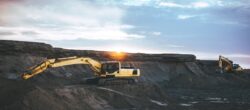ANGOLA, A STORY OF ADVANCING GROWTH PROSPECTS
Demand for Angola’s mineral wealth, driven by the fallout from the Russia-Ukraine war, is garnering growing international support and much-needed infrastructure development
Angola has a veritable Royal Flush in the hand of minerals dealt it by geology. Reserves of oil, diamonds, gold, and now its deposits of 31 of the world’s 50 different critical minerals are winning the country considerable international attention. While oil is the major export, at over 90% of revenues, and Angola is long established in the mining world as the fourth largest diamond producer, the government has only recently been raising the profile for its battery minerals.
Now President Joao Lourenco, having won confidence at home and abroad for a second term, is taking advantage of the international energy transition and planning international tours to showcase these coveted resources. This is against the background of forecasts of rising demand for clean energy-related minerals, with the World Bank publishing a figure of an increase of 500% by 2050.
Highly influential international rating agency, Fitch Solutions, welcomed President Joao Lourenco’s re-election, saying that: ”The new National Development Plan (2023-2027) and updated exchange rate regime, which came into force on February this year for the mining sector, will encourage new investment and develop the mining sector. The Russia-Ukraine war has triggered developments in Angola’s mining sector. The subsequent sanctions on Russia-based companies has left a gap for alternative mining companies and investment…….” While cobalt, nickel, copper, diamonds and gold have been of interest to investors – there are 20 mining projects in Angola overall, owned by 19 companies – in recent years, rare earths have been added.
The national plan will form the backbone of a new Mining Sector Development Plan for 2023-2027, which will be overseen by the Minister of Mineral Resources, Oil and Gas, Diamantino Azevedo. Welcoming this, an editorial in Mining Review commented: “ A German-trained mining engineer, Azevedo has a strong appreciation of Angola’s potential, having lectured in mineral economics at the Universidade Agostinho Neto (UAN) in Luanda and served as CEO of Ferrangol (a state company which manages Angola’s iron ore production) prior to entering government in 2017. Azevedo’s technical expertise and Lourenço’s political will promises to take Angola’s mining industry to new heights.”
Growing stability is attractive
Government measures to boost foreign direct investment, and the country’s growing social and economic development and stability, are all encouraging international interest in Angola. This is presenting, as international analysts at the UK’s Economic Intelligence Unit comments, “a minimal risk of protest” – distinct progress after the 27 years of civil war. Responding to all of this, UK-based Lloyds Bank sees the country as having become “ attractive for FDI in recent years.”
Additionally, President Joao Lourenco has been reinforcing links with the US and EU, and in October (this month) Angola announced a first sustainable investment facilitation agreement with the EU. The Brussels’ press release read: “This is the first agreement on sustainable investment facilitation that the EU ever negotiated. Angola’s economy is currently based on its abundant raw materials and energy resources. Thanks to this agreement, Angola will be able to diversify its economic model and improve the investment climate for foreign and local investors.” Angola is the 7th largest investment destination on the African continent for investors from the EU, covering 5.4% of the EU’s stock of foreign direct investment (EUR 9.9 billion of FDI in 2020).
Positive economic momentum took hold in 2022, with the economy growing by 2.6% following a gain of 0.7% the previous year, ending a five-year recession. Growth, a US Statement Department paper on the country has just reported, is expected to boost the economy by 3.2 % this year, alongside annual population growth of 3.3%.
Transparency and hopes for infrastructure
Backing growth is Angola’s membership of the Extractive Industries Transparency Initiative, which it joined in June 2022 to increase transparency in the oil, gas, and mineral resource sectors. Plaudits include the fact that the United Nations (UN) has announced that Angola will graduate from the Least Developed Countries category in February 2024.
However, infrastructure needs much work. The critical mineral resources in Angola include cobalt, copper, graphite, iron, lithium, manganese, neodymium, nickel, praseodymium and zinc with covetable potential for large-scale exploitation. Global demand for these metals, vital for energy source transformation, could be just the driver that is needed to revamp and modernize Angolan infrastructure, for example, such as its sections of the railway systems of the west-central coast of Southern Africa region, notably the 1,700 km Lobito rail corridor.
One of the busiest transport routes in Africa in the last century, this corridor could significantly reduce costs by enabling trade in critical minerals and other commodities to avoid trucking via the congested road and ports systems. A 30-year concession to rehabilitate and operate the line, which links Angola’s seaport of Lobito to the heart of the Democratic Republic of the Congo’s copper-belt, was signed this summer.
Welcomed by both Washington and Brussels, which have both given assistance for the launch of pre-feasibility studies, this $555-million project is partially funded by the United States, via the US International Development Finance Corporation (DFC). Other consortium members include global commodity trader Trafigura and Portuguese constructor and port operator, Moto-Engil. In a widely reported comment, analysts at British think-tank Chatham House commented that this westward-looking project formed “a historical watershed”.
Corporate activity is visibly increasing, notably in oil and gas, but this has enabling Angola to establish a good track record with international investors and corporations for its mining operations. US law firm White & Case, in its summer 2023 review of the African economy, states that: “Dealmaking in Angola’s oil and gas sector is even shaping the face of African M&A,” pointing to $15-billion of transactions, 70% of the continent’s total.
In mining, diamonds are expected to continue to dominate Angola’s mining industry for some time – the government has promoted efforts to build a local production industry in order to increase exports of finished products, backing the creation of a whole value chain and inaugurating a hub with cutting and polishing capacity. The potential remains vast – so far only 40% of the country’s diamond prospects have been exploited.
Backing from big players
Positive for the whole country is the return of De Beers to Angola, and its comments that the country “has worked hard in recent years to create a stable and attractive investment environment”. Alrosa, Rio Tinto and Anglo American have significant investments in Angola in diamonds, too, but also in copper, cobalt and nickel, points out Portuguese law firm VdA in its entry for Angola on the industry research website, Chambers Practice Guide.
Critical minerals production, however, is beginning, says VdA, to have an impact and these minerals, are expected to become the main driver for mining’s expansion and thus its contribution to the country’s GDP. “The forecast is that Angola’s mining production will trend at 1.6% in 2023 and 3% in 2024, as private investment in greenfield and brownfield projects increase, “ it states in its latest look at the country’s development.
In its review of the critical minerals VdA states that the “Pensana Rare Earth’s Longonjo project is also worth noting.” This is “set to become the first large-scale neodymium and praseodymium (NdPr) rare earth mine in Africa, with a production target of 56,000 tonnes per year.” The products from the project, which is worth well over $2bn, will be used in wind turbines and EVs. It is likely to be the front-runner for further companies to invest in Angola.
London-based Pensana is backed by major UK asset manager, M&G Investment Management (£342bn under management), and the $3bn Angolan sovereign wealth fund. They are joint venturing a project to build a$195m rare earths refinery in England, partnered with a $3 mine in Angola in which they have stakes of 13% and 23% respectively. Pensana has started to build a $195m plant at the UK north-east port of Hull, which will be fed with ore from Angola where $305m is being spend developing the mine. The refinery would be one of only a handful of its kind outside China if it starts as planned in 2026.
Welcoming the project, the online news agency Innovation Networks, reported that “initially, the company plans to sell 50% of the UK refinery production directly to an Asian motor magnets manufacturer, while talks are held with major automotive original equipment manufacturers in Europe and the US for potential offtake agreements further down the line.” For the Angolan Government, it added, the Longonjo project represents a significant step towards diversification, and demonstrates an increasing openness to international and private investment.
Another recent newcomer seeking to exploit Angola’s critical metals is Australian gold and nickel prospector Tyranna Resources. It has acquired an interest in the Namibe Lithium Project and has funding from international Chinese mining, technology and rare earths company Sino Mind Group. The attractions for Tyranna include the location of its project near deep water ports and government support.
As new companies sign up to Angola, the signs are looking very promising for the country to repeat its successes in other minerals and win and profit in a big way from its critical mineral wealth.
To find out more about Angola mining investment opportunities, it maybe worthwhile to attend, AME trade’s upcoming 2nd Angola Mining Conference , planned to hold in Luanda,Angola 22-23rd November
For more information please visit https://amcangola.com/






